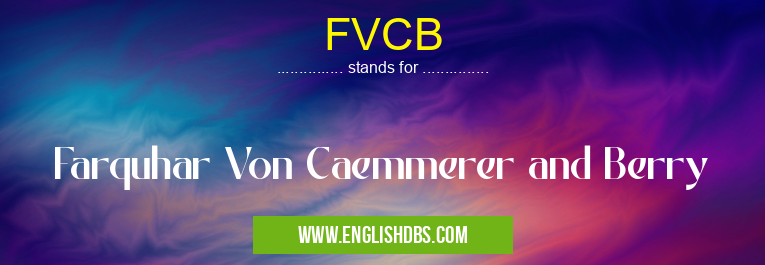What does FVCB mean in UNCLASSIFIED
FVCB stands for Farquhar, Von Caemmerer, and Berry. It is widely used in the field of plant physiology and refers to a mathematical model that describes the relationship between leaf photosynthesis and environmental factors.

FVCB meaning in Unclassified in Miscellaneous
FVCB mostly used in an acronym Unclassified in Category Miscellaneous that means Farquhar Von Caemmerer and Berry
Shorthand: FVCB,
Full Form: Farquhar Von Caemmerer and Berry
For more information of "Farquhar Von Caemmerer and Berry", see the section below.
Key Points
- The FVCB model is a widely accepted and used model for studying leaf photosynthesis.
- It was developed by three scientists: Graham Farquhar, Sven von Caemmerer, and John Berry.
- The model takes into account various environmental factors that influence photosynthesis, including light intensity, temperature, and CO2 concentration.
- It can be used to predict the rate of photosynthesis under different environmental conditions.
Applications
- The FVCB model is used in a variety of applications, including:
- Crop modeling: Predicting crop yields and optimizing crop management practices.
- Climate change research: Assessing the impact of climate change on plant growth and productivity.
- Plant breeding: Developing new plant varieties with improved photosynthetic efficiency.
Essential Questions and Answers on Farquhar Von Caemmerer and Berry in "MISCELLANEOUS»UNFILED"
What is FVCB?
FVCB stands for Farquhar Von Caemmerer and Berry. It is a model that describes the relationship between photosynthesis and the concentration of carbon dioxide (CO2) in the atmosphere.
How does the FVCB model work?
The FVCB model divides photosynthesis into two phases: the carboxylation phase and the regeneration phase. The carboxylation phase is the initial stage of photosynthesis, where CO2 is fixed into organic compounds. The regeneration phase is the second stage, where the organic compounds are broken down to release CO2 and regenerate the enzyme Rubisco.
What are the key parameters of the FVCB model?
The key parameters of the FVCB model are the maximum rate of carboxylation (Vcmax), the maximum rate of regeneration (Jmax), and the Michaelis constant for CO2 (Kc). Vcmax is the rate of carboxylation at saturating CO2 concentrations, Jmax is the rate of regeneration at saturating CO2 concentrations, and Kc is the CO2 concentration at which the rate of carboxylation is half of Vcmax.
How is the FVCB model used?
The FVCB model is used to predict the rate of photosynthesis under different environmental conditions. It is used in a variety of applications, including crop modeling, climate modeling, and ecological research.
What are the limitations of the FVCB model?
The FVCB model is a simplified representation of photosynthesis. It does not account for all of the factors that can affect photosynthesis, such as temperature, light intensity, and water availability. However, the FVCB model is a useful tool for understanding the general relationship between photosynthesis and CO2 concentration.
Final Words: The FVCB model is a valuable tool for understanding and predicting leaf photosynthesis. It has been extensively used in plant physiology research and has practical applications in agriculture and climate change research.
